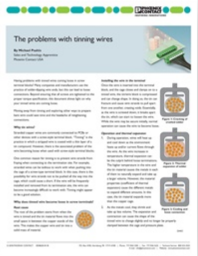The problems with tinning wires
Many companies and manufacturers use the practice of solder-dipping wire ends, but this can lead to loose connections. Beyond ensuring that all screws are tightened to the proper torque specifi cation, this document shines light on why your tinned wires are coming loose. Moving away from tinning and exploring other ways to prepare bare wire could save time and the headache of retightening connections.
Download this whitepaper to find out more.
Read More
By submitting this form you agree to Phoenix Contact contacting you with marketing-related emails or by telephone. You may unsubscribe at any time. Phoenix Contact web sites and communications are subject to their Privacy Notice.
By requesting this resource you agree to our terms of use. All data is protected by our Privacy Notice. If you have any further questions please email dataprotection@techpublishhub.com
Related Categories: cooling


More resources from Phoenix Contact

Push-in Relays: Faster Connections
Today's industrial control engineers and installers need to save space in the cabinet and reduce installation time. They need connection technology...

So Many Wireless Technologies … Which Is the Right One for My Application?
Wireless technology has been used in industry for many years and has provided reliable communications for monitoring and controlling remote process...

Why surge protection is necessary
Modern industrial, commercial, and residential life depend on the availability of electricity. The electricity supplied must be at a level of quali...
